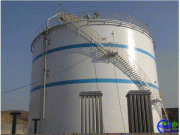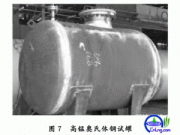免职声明:本网站为公益性网站,部分信息来自网络,如果涉及贵网站的知识产权,请及时反馈,我们承诺第一时间删除!
This website is a public welfare website, part of the information from the Internet, if it involves the intellectual property rights of your website, please timely feedback, we promise to delete the first time.
电话Tel: 19550540085: QQ号: 929496072 or 邮箱Email: Lng@vip.qq.com
摘要:LNG AND AMERICA’S FUTURE There is a call for the United States to gain more control over its energy future. One of the most effective and achievable means of doing so is diversifying the energy sources from which our nation draws. Bringing more L..
LNG AND AMERICA’S FUTUREThere is a call for the United States to gain more control over its energy future. One of the most effective and achievable means of doing so is diversifying the energy sources from which our nation draws. Bringing more LNG into our supply mix reduces our reliance on any one region for supplies. Liquefied Natural Gas can and should be an important source of energy for the United States. It can help us meet our growing need for clean and affordable natural gas to ensure that consumers have the resources they need to stay warm in the winter, the confidence in the stability of energy costs and a prosperous economy. LNG can help meet growing U.S. demand for natural gas. LNG currently provides approximately 2.8% of the nation’s natural gas, a figure that is predicted to increase to 16% by 2030, according to the U.S. Department of Energy. NATURAL GAS IS CRITICAL TO THE NATIONNatural gas accounts for about one quarter of all energy used in the United States. In 2001, natural gas accounted for 45% of the residential energy demand, 38% of industrial energy demand, 40% of commercial energy demand, 3% of the transportation sector’s energy demand and 14% of the energy used for electricity generation. Source: U.S. Department of Energy MEETING NATURAL GAS DEMAND WITH LNGU.S. demand for natural gas is outstripping domestic supply as well as available Canadian supply. Demand is high for natural gas because it is a clean-burning alternative to coal and other petroleum products, such as oil – especially for generating electricity. By 2030, the gap between demand and supply is projected to reach 21%. As we exhaust domestic supplies of natural gas, the United States will need to rely increasingly on natural gas that is brought in from overseas. To bring it to our shores, this gas must be converted into a liquid – LNG – before it is shipped. LNG helps the nation meet its very real and pressing need for new energy supplies now. There are, however, only five U.S. facilities (and one facility in Puerto Rico) currently capable of importing LNG – not nearly enough to handle the amount of LNG needed. In order to meet growing demand for natural gas, the United States will need more LNG import terminals. Additional LNG import terminals will allow the United States to expand and diversify our natural gas supplies. More LNG imports will mean less pressure on natural gas prices in America, and will reduce the impact that rising prices are having on American industry and the American consumer. View the locations of the existing and proposed new LNG import terminals. A MAJOR BARRIER TO LNG MARKET GROWTH IN THE UNITED STATESBuilding new LNG import terminals around the country is critical to bridging the ever-increasing natural gas demand and supply gap in the United States. Expanding and diversifying the supply strengthens the country, reducing our reliance on any single supplier and helping avoid or minimize price shocks. Despite their importance to the nation’s energy future, the construction of new LNG import terminals has been met with opposition in many communities. Construction of an LNG terminal in the United States involves a rigorous permitting process involving federal, state and local agencies. A typical facility requires over 40 permits. Although Environmental Impact Statements for proposed LNG facilities indicate that terminals pose little risk to nearby communities, approvals to construct new facilities are far from certain. Accurate information on LNG needs to be shared with residents so they can make informed decisions. No death or serious accident has occurred at an onshore U.S. LNG facility in 25 years. There has never been a fire, significant spill or accidental death (because of an LNG release) on an LNG ship in the history of the industry. This excellent safety record is a result of the LNG industry's stringent design and operating standards, supported by strong regulatory oversight. |

















